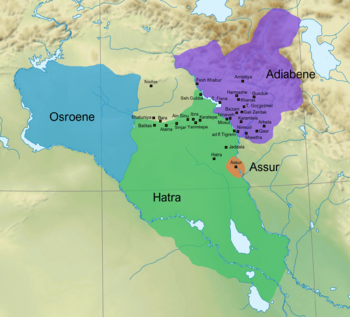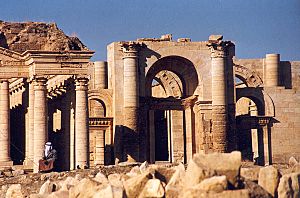Kingdom of Hatra facts for kids
Quick facts for kids
Kingdom of Hatra
|
|||||||||
|---|---|---|---|---|---|---|---|---|---|
| 2nd century CE–241 | |||||||||

Approximate map of the kingdom of Hatra (green) and other Parthian Mesopotamian vassal kingdoms in AD 200
|
|||||||||
| Status | Autonomous state, frequently a vassal of the Parthian Empire | ||||||||
| Capital | Hatra | ||||||||
| Common languages | Hatran Aramaic Old Arabic |
||||||||
| Religion |
Hybrid of:
|
||||||||
| Government | Monarchy | ||||||||
| King | |||||||||
| History | |||||||||
|
• Established
|
2nd century CE | ||||||||
|
• Fall of Hatra
|
241 | ||||||||
|
|||||||||
| Today part of | Iraq | ||||||||
The Kingdom of Hatra was an ancient Arab kingdom. It existed in what is now northern Iraq during the 2nd century CE. This kingdom was often under the control of the Parthian Empire. It was located between the powerful Roman Empire and the Parthian Empire. Hatra was also known as the Kingdom of Arabaya or Araba.
Contents
What's in a Name?
The name "Hatra" appears many times in ancient writings. These writings are in a language called Hatran Aramaic. The word 𐣧𐣨𐣣𐣠 (ḥṭrʾ) likely means "enclosure" or "fence."
History of Hatra
We don't know much about Hatra's early history. Some people think a settlement might have been there even earlier. This could have been during the Neo-Assyrian Empire or the Achaemenid Empire. But this is just a guess.
The first clear records of Hatra are from the late 1st century CE. Early leaders of Hatra used the title marya, which means "lord." Around the 170s CE, they started using the title malka, meaning "king." They often called themselves "King of the Arabs."
Hatra became more important when the Roman Empire took over Edessa in 165 CE. This made Hatra the westernmost part of the Parthian Empire. Its location became very important for trade and defense.
Hatra's Rise to Power
During the 1st and 2nd centuries, Arab princes ruled Hatra. The city of Hatra became a major capital and a key religious center. This was because of its important location along busy trade routes.
Hatra was one of the first Arab kingdoms to form outside the Arabian Peninsula. Other early Arab states included Osroene and the Kingdom of Emesa. Later ones were the Ghassanids and the Lakhmids. These kingdoms often acted as buffer states between larger empires.
The Fall of Hatra
Hatra was a strong city. It successfully defended itself against attacks from Roman emperors Trajan and Septimius Severus. It also survived an attack from the Sasanian king Ardashir I.
However, the kingdom eventually fell. The city of Hatra was destroyed in 241 CE. This happened during the Fall of Hatra when the Sasanians, led by Shapur I, conquered it.
Hatra's Culture
Hatra was part of what historians call the "Parthian commonwealth." This term describes cultures that were under Parthian control. These areas were mainly home to non-Iranian people.
Even though Hatra's language and religious practices were similar to other Aramaic-speaking areas, the Parthian Empire had a big impact. This influence shaped Hatra's culture and government. We know this from ancient writings and things found by archaeologists.
Parthian Influence
Many Parthian titles were used in Hatra. These titles were also used in places like Armenia. For example, the title naxwadār was used. Other titles included pasāgrīw (meaning "heir-apparent") and bitaxs (possibly "viceroy").
People in Hatra also used Iranian personal names. The ruling family even used names like Worod, Walagash, and Sanatruq. These were the same names used by the Arsacid kings of Parthia. The local people also wore Parthian clothing, used Parthian jewelry, and carried Parthian weapons.
Gods and Beliefs
People in the Kingdom of Hatra honored many different gods. These gods came from various religions. They included gods from Sumero-Akkadian, Greek, Aramean, and Arabian beliefs.
Rulers of Hatra
| Name | Title | Date | Portrait | Note | |
|---|---|---|---|---|---|
| 1 | Worod | mry´ | |||
| 2 | Ma’nu | mry´ | |||
| 3 | Elkud | mry´ | 155/156 | ||
| 4 | Nashrihab | mry´ | 128/29 - 137/38 AD | ||
| 5 | Naṣru | mry´ | 128/29 - 176/77 | ||
| 6 | Wolgash I | mry´ and mlk | |||
| 7 | Sanatruq I | mry´ and mlk | 176/177 | Ruled together with Wolgash I | |
| 8 | Wolgash II | ||||
| 9 | Abdsamiya | mlk | 192/93 - 201/202 | Supported the Roman emperor Pescennius Niger | |
| 10 | Sanatruq II | mlk | 207/08 - 229/230 | Became a vassal of the Romans under Gordian III during Roman-Persian Wars | |
See also
- Arbayistan (Arbaya), the Sasanian province
Sources
- Michael Sommer: Hatra. Geschichte und Kultur einer Karawanenstadt im römisch-parthischen Mesopotamien. von Zabern, Mainz 2003, ISBN: 3-8053-3252-1, p. 23.


